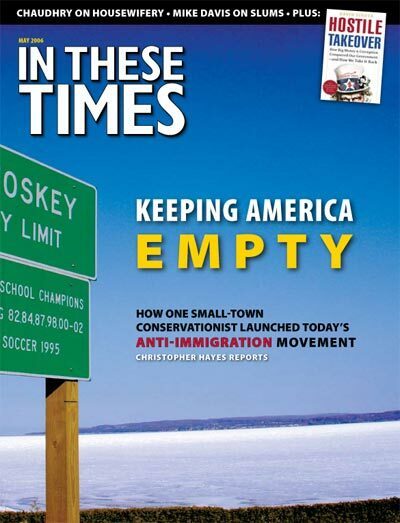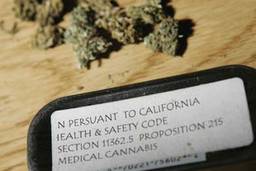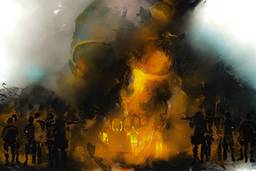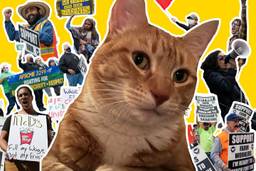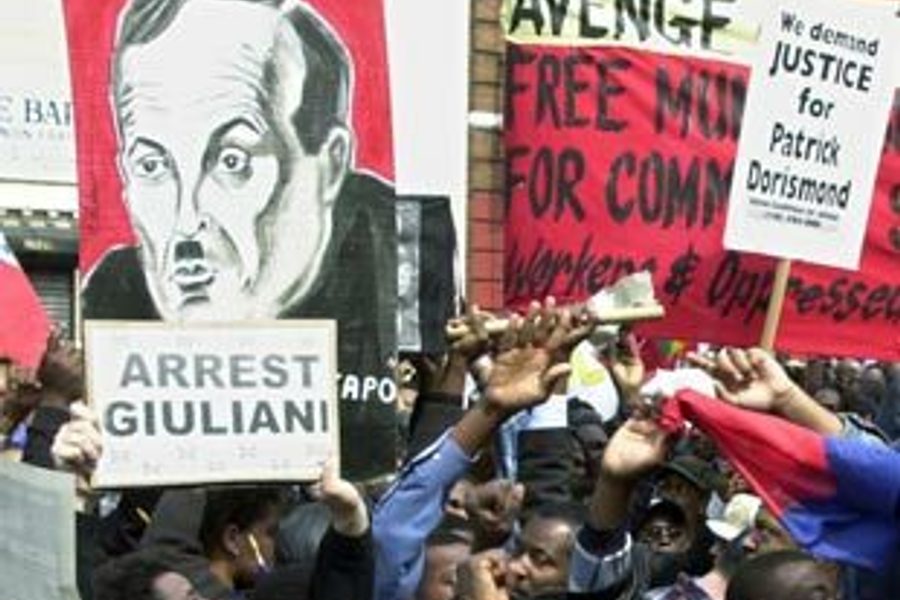
Rudolph Giuliani’s eight years as mayor of New York bridged two political eras: the racially coded politics of the late 20th century, which targeted the “pathological” African-American poor as Public Enemy No. 1, and the post-9/11 police state, which transformed dissenters into “terrorist” suspects.
Of course, the conventional wisdom lauds Giuliani as “the man who cleaned up New York” and “the hero of 9/11.” Kevin Keating’s forthcoming documentary, Giuliani Time, deconstructs that legend with a mix of interviews, period news footage, and the occasional bit of Michael Moore-style humor. The film opens May 12 in New York.
The Giuliani Time follows Giuliani’s rise from the son of a small-time mobster to a federal prosecutor in the Reagan administration, where he gained prominence for his vindictive pursuit of mobsters and Haitian refugees. It tracks his mayoralty from the unofficial opening of his 1993 campaign, leading a mob of white cops in shouting “Bullshit” at City Hall (then occupied by David Dinkins, New York’s first black mayor), to his political collapse in 2000, when cancer and much-publicized marital problems forced him to drop out of a Senate race against Hillary Clinton.
Crime-fighting is the cornerstone of the Giuliani legend. In 1990 and 1991, with heavily armed gangs battling for control of the crack trade, the city averaged six murders a day. Giuliani supporters such as Myron Magnet of the Manhattan Institute, his main advocate in this film, simply point to the numbers: By the time Giuliani left office, crime had dropped to the levels of the mid-’60s, with murders below three a day. But the decline of New York crime in the ’90s began under Dinkins and paralleled a nationwide decline. Did Giuliani’s policies – in particular, “quality of life” policing, prosecuting small offenses like public drinking and pot-smoking (and even reviving a Prohibition-era ban on dancing in bars!) – really bring it down in New York? William Bratton, Giuliani’s first police commissioner (who admits he never got along with the mayor) cites the use of computers to pinpoint high-crime locations – and the 6,000 new police officers hired by Dinkins.
“Quality of life” policing was actually most successful in reducing the perception of crime. Giuliani’s campaign against the menace of “squeegee men” epitomized this; it played to the fears of white car owners who were so terrified of being accosted by a ragged-looking black man that they wanted them all locked up.
But the racial subtext of Giuliani’s policies eventually caused his political downfall. The 1999 police killing of Amadou Diallo, an African immigrant shot 19 times because he pulled a wallet during a police stop, cracked the mayor’s invincibility. Giuliani dismissed the ensuing protests as “silly,” which translated to many as callous and racist.
The other key racial-code issue of the era was welfare. Giuliani imposed a punitive mandatory-work policy, using welfare recipients to do laid-off city workers’ old jobs for less than minimum wage while couching it in rhetoric about “ending dependency.” The film juxtaposes black welfare recipients complaining that they need “real jobs” with footage of Giuliani welfare commissioner Jason Turner, who responds to a union leader’s complaint about “slave labor” by declaring, “Work is what sets you free.” (That’s “Arbeit macht frei” in German, but Keating opts to cut to an old movie-comedy version of a 19th-century workhouse instead of to the more sinister inscription over the gates of Auschwitz.)
Was Giuliani a racist? Former city education commissioner Rudy Crew, one of the few black officials in his administration, says his support of school vouchers was racist. And all three of Giuliani’s mayoral races were racially polarized: He won more than two-thirds of the white vote and less than 20 percent of the black vote.
The film largely skips over two significant areas: Giuliani’s policies on housing and protest suppression. The mayor expended a lot of venom on homeless people begging for quarters, but the landlords raising rents past $1,000 a month were among his biggest supporters. He cut the city’s housing-construction programs dramatically and he discreetly supported the gutting of its rent controls. The city’s housing crisis has accelerated; today, homelessness is the highest it’s been since the Depression, and nearly 29 percent of New York tenants spend more than half their income on rent, up from 25 percent in 2002.
Giuliani also pioneered many of the tactics against political protests that have gone national since 9/11: an overwhelming and overbearing police presence, pre-emptive arrests, and corralling demonstrators into cattle pens. His successor, the less puritanical but more plutocratic Michael Bloomberg, has amplified those policies, denying permits for large antiwar rallies and jailing almost 2,000 people during the 2004 Republican Convention.
While the film begins and ends with images of Giuliani talking about the 9/11 attacks, it doesn’t do much to dissect his image as a “hero” of 9/11 – the moment of his political resurrection, and perhaps the most overrated part of the Giuliani legacy. Maybe he looked courageous next to the scared rabbit staring at My Pet Goat, but his most concrete response to the attacks was trying to get the 2001 mayoral election postponed, on the grounds that only he could handle the crisis.
Giuliani Time posits itself as a warning in case the former Duce of Gotham runs for president. He may be too “liberal” for the Republicans’ Talibanic wing – he’s spent more time schmoozing rich gay campaign donors than crusading against sodomite abominations – but if he does gain traction, be afraid.
